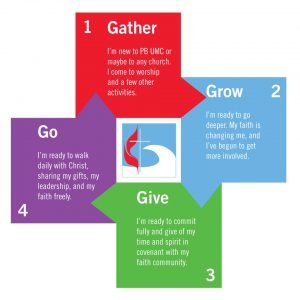Note: This series is based on resources from the General Board of Discipleship of The United Methodist Church.
This Sunday, we begin a short Lectionary series that explores ideas of Discipleship and of expanding the church into the community. Using imagery and language from a nationwide media campaign from The United Methodist Church, we are asking whether or not our congregation is really seeing the people in our communities to whom God is calling us to reach.
In this week’s Gospel text, we begin with the Luke version of the Sermon on the Plain (more commonly known as the Sermon on the Mount from Matthew’s telling). Verse 17 tells of a huge crowd of people from several locales who came to hear and to be healed. They seem to be eager for both spiritual and physical whole-ness.
Luke 6:17-26 (CEB)
17Jesus came down from the mountain with them and stood on a large area of level ground. A great company of his disciples and a huge crowd of people from all around Judea and Jerusalem and the area around Tyre and Sidon joined him there. 18They came to hear him and to be healed from their diseases, and those bothered by unclean spirits were healed. 19The whole crowd wanted to touch him, because power was going out from him and he was healing everyone.20Jesus raised his eyes to his disciples and said:
“Happy are you who are poor,
because God’s kingdom is yours.
21Happy are you who hunger now,
because you will be satisfied.
Happy are you who weep now,
because you will laugh.22Happy are you when people hate you, reject you, insult you, and condemn your name as evil because of the Human One. 23Rejoice when that happens! Leap for joy because you have a great reward in heaven. Their ancestors did the same things to the prophets.
24But how terrible for you who are rich,
because you have already received your comfort.
25How terrible for you who have plenty now,
because you will be hungry.
How terrible for you who laugh now,
because you will mourn and weep.
26How terrible for you when all speak well of you.
Their ancestors did the same things to the false prophets.
Consider these questions:
- What part of the crowd do you most identify with? Are you eager to hear Jesus? Hoping to be healed? Skeptical? Just want to see a miracle? Something else?
- How does Jesus characterize the “happy” (other translations say “blessed”) in this passage (v20-23)? To whom does Jesus address “terrible” (other translations say “woe”) in this passage (v24-26)? Which of the four “terriblest” (or “woes”) are most convicting to you?
Post-Sermon Update on 2/19
Audio from the sermon can be heard below, and video can be found at this link (will open in a new tab).
We opened the message with a discussion about crowds and my own experience of a large crowd playing with a band at San Francisco Pride in the mid- to late-nineties. I also referenced this great quote from the movie Men in Black.
But when it comes to the crowd to whom Jesus spoke on the plain, the crowd was very different. They were seeking something. They were reaching for Jesus.
And if we’re honest with ourselves, don’t we find ourselves doing the same thing? Don’t we find ourselves reaching for Jesus?
But we also must understand that reaching for Jesus isn’t the end. Because reaching for Jesus – really authentically reaching with the sure and certain hope of connecting – brings about transformation. This journey of faith is about being transformed into faithful disciples of Jesus Christ.
 To this end, I introduced a potential framework that we might use as a guide on our journey of discipleship. We are continuing to work through this potential model and finding ways to help members and participants at PB UMC to move along these steps and to grow as disciples. These simple descriptors help us to see where we are on our individual faith journey, and more details will come to guide us in moving along this path.
To this end, I introduced a potential framework that we might use as a guide on our journey of discipleship. We are continuing to work through this potential model and finding ways to help members and participants at PB UMC to move along these steps and to grow as disciples. These simple descriptors help us to see where we are on our individual faith journey, and more details will come to guide us in moving along this path.
As we continue to grow in discipleship, I believe we will find ourselves drawn to connect with our communities in new and profound ways. One example was discussed on Sunday morning, but a technical glitch prevented it from being shown during one of the services. I leave it here for your consideration.
Consider these questions:
- Through this discussion, we’ve identified different types of crowds. What do you think this crowd was like? Why?
- When is a time that you were reaching for Jesus? What were the circumstances? Did you experience some kind of response? Was it the response you were expecting?
- Looking at the four-step discipleship graphic, where do you see yourself? What would help you to move along these steps into a fuller experience of discipleship?
